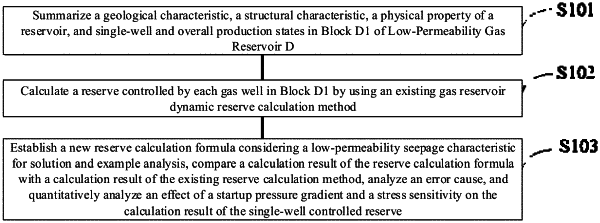| CPC E21B 49/00 (2013.01) [E21B 47/06 (2013.01)] | 4 Claims |

|
1. A method for calculating a single-well controlled reserve of a low-permeability/tight gas reservoir and analyzing residual gas thereof, wherein the method comprises:
(1) establishing a new method for calculating the single-well controlled reserve of the low-permeability and tight gas reservoirs on the basis of a startup pressure gradient c, a stress sensitivity, and a slippage effect γ;
(2) obtaining parameters of a gas well to be tested and production interval, wherein the parameters comprise a wellbore radius rw an average viscosity of natural gas μ, an original formation pressure pi, an original gas deviation factor Zi, a formation temperature T, a surface temperature Tsc, a porosity of gas reservoir Ø, an original average permeability K0, a maximum permeability damage rate Dk3, an average gas deviation factor Z, a surface pressure psc, a thickness of gas reservoir h, a natural gas density ρ, and a supply radius re; wherein the startup pressure gradient c and the slippage effect γ are determined based on the original average permeability K0, and the stress sensitivity is characterized by the maximum permeability damage rate Dk3; and
(3) determining a single-well controlled reserve of the gas well to be tested based on the obtained parameters by using the established new method for calculating the single-well controlled reserve of low permeability and tight gas reservoirs;
wherein the new method for calculating the single-well controlled reserve of the low-permeability and tight gas reservoirs is established on the basis of the startup pressure gradient c, the stress sensitivity and the slippage effect γ by:
a pressure p at a certain point in a formation of the gas reservoir is expressed as a function of a position r and a time t as:
p=p(r,t) (1)
a motion equation of unsteady gas seepage considering an effect of the startup pressure gradient is:
 wherein, a second term in the right of equal sign describes near-wellbore high-speed non-Darcy seepage; ν′ is approximately expressed as:
 therefore, ν in the formula is expressed as:
 a continuity equation of gas seepage is:
 a state equation of gas seepage is:
pV=ZnRT (6)
wherein, an effect of the stress sensitivity is characterized by the maximum permeability damage rate D considering the slippage effect γ and the stress sensitivity, a permeability is expressed as:
 according to field experience, a relationship between the block's startup pressure gradient and permeability is:
c=0.0672e−0.723K0 (8)
a relationship between a turbulence factor and the permeability is further obtained:
 when a reservoir permeability is less than 0.1 mD, a relationship between the slippage effect and the permeability is:
γ=0.86K0−0.33 (10)
through a sampling test of a fluid from the analysis block, a relationship between a deviation factor Z and an average formation pressure p obtained:
Z=0.000365p2−0.008726p+0.936954 (11)
wherein, a regression coefficient R2=0.9979, showing a good regression effect equations (1)-(4) are combined with equations (6)-(11), and a combination result is brought into the continuity equation (5) to obtain a differential equation of gas seepage in the low-permeability and tight gas reservoirs, which considers the slippage effect, the startup pressure gradient c and the permeability stress sensitivity:
 wherein, qsc is a function of time t, and a specific function relationship is determined by regression and matching of actual production data:
qsc=F(t) (13)
the equation (13) is substituted into the equation (12) to obtain:
 wherein an initial condition and boundary conditions are:
initial condition:
p(r,0)=pi (15)
internal boundary condition:
 external boundary condition:
 under the initial condition (15) and the boundary conditions (16) and (17), the partial differential equation (14) is solved to obtain the relationship between the formation pressure p and the position r and the time t.
|